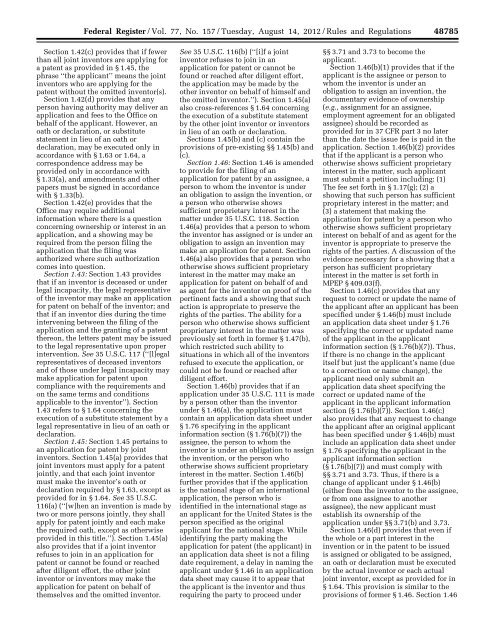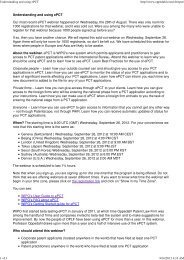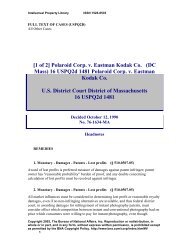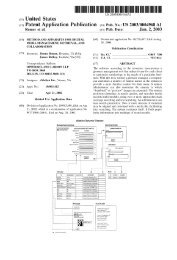sro<strong>be</strong>rts on DSK5SPTVN1PROD with RULES48784 Federal Register / Vol. 77, No. 157 / Tuesday, August 14, 2012 / Rules and Regulationsthe applicant (note that all paperssubmitted on <strong>be</strong>half of a juristic entitymust <strong>be</strong> signed by a patent practitioner).Thus, there is no need to referseparately to the applicant and anassignee of the entire interest of theapplicant. This change is forconsistency with the change in practiceconcerning the applicant for patent in§ 1.42. In addition, the patent owner isthe owner of the entire interest of apatent. Section 1.36(a) is also amendedto change the parenthetical ‘‘or fewerthan all of the assignees of the entireinterest of the applicant or, in areexamination proceeding, fewer thanall the owners of the entire interest ofa patent’’ in the third sentence to ‘‘orfewer than all patent owners in asupplemental examination orreexamination proceeding.’’ Section1.36(a) is also amended to change thephrase ‘‘but the assignee of the entireinterest of the applicant may revokeprevious powers of attorney and giveanother power of attorney of theassignee’s own selection as provided in§ 1.32(b)’’ in the ultimate sentence to‘‘but the assignee may <strong>be</strong>come theapplicant under § 1.46(c) and revokeany previous power of attorney andgrant a power of attorney as provided in§ 1.32(b).’’Section 1.41: Section 1.41(a) providesthat an application must include, or <strong>be</strong>amended to include, the name of theinventor for any invention claimed inthe application (the inventorship). See35 U.S.C. 115(a). As discussedpreviously, the ‘‘applicant’’ is providedfor in § 1.42.Section 1.41(b) provides that theapplicant may name the inventorship ofa nonprovisional application under 35U.S.C. 111(a) in the application datasheet in accordance with § 1.76 or theinventor’s oath or declaration. Section1.41(b) specifically provides that theinventorship of a nonprovisionalapplication under 35 U.S.C. 111(a) is theinventor or joint inventors set forth inthe application data sheet in accordancewith § 1.76 filed <strong>be</strong>fore or concurrentlywith the inventor’s oath or declaration.An application data sheet must <strong>be</strong>signed (§ 1.76(e)) to comply with § 1.76.An unsigned application data sheet istreated as only an applicationtransmittal letter. See § 1.76(e). Section1.41(b) also provides that if anapplication data sheet is not filed <strong>be</strong>foreor concurrently with the inventor’s oathor declaration, the inventorship is theinventor or joint inventors set forth inthe inventor’s oath or declaration,except as provided for in §§ 1.53(d)(4)(continued prosecution applications)and 1.63(d) (continuing applications).Section 1.41(b) also provides that oncean application data sheet or theinventor’s oath or declaration is filed ina nonprovisional application, anycorrection of inventorship must <strong>be</strong>pursuant to § 1.48. Section 1.41(b)finally provides that if neither anapplication data sheet nor the inventor’soath or declaration is filed during thependency of a nonprovisionalapplication, the inventorship is theinventor or joint inventors set forth inthe application papers filed pursuant to§ 1.53(b), unless the applicant files apaper, including the processing fee setforth in § 1.17(i), supplying the name ornames of the inventor or joint inventors.Applicants who wish to takeadvantage of the ability to name theinventors in an application data sheetrather than the inventor’s oath ordeclaration should take care to ensurethat an application data sheet under§ 1.76 that is signed in compliance with§ 1.33(b) is present on filing, or at leastis filed prior to the filing of anyinventor’s oath or declaration in theapplication. If an inventor’s oath ordeclaration is filed in the applicationprior to the filing of an application datasheet under § 1.76 that is signed incompliance with § 1.33(b), theinventorship named in the inventor’soath or declaration controls. Forexample, if an inventor’s oath ordeclaration naming only inventor ‘‘A’’ ispresent on filing without anaccompanying application data sheet,and a signed application data sheetnaming inventors ‘‘A’’ and ‘‘B’’ issubsequently filed in the application,the application will <strong>be</strong> treated asnaming only inventor ‘‘A’’ (the inventorprovided in the inventor’s oath ordeclaration) until the inventorship iscorrected under § 1.48(a).Section 1.41(c) provides that theinventorship of a provisionalapplication is the inventor or jointinventors set forth in the cover sheet asprescri<strong>be</strong>d by § 1.51(c)(1). Section1.41(c) also provides that once a coversheet as prescri<strong>be</strong>d by § 1.51(c)(1) isfiled in a provisional application, anycorrection of inventorship must <strong>be</strong>pursuant to § 1.48. Section 1.41(c)finally provides that if a cover sheet asprescri<strong>be</strong>d by § 1.51(c)(1) is not filedduring the pendency of a provisionalapplication, the inventorship is theinventor or joint inventors set forth inthe application papers filed pursuant to§ 1.53(c), unless the applicant files apaper including the processing fee setforth in § 1.17(q), supplying the name ornames of the inventor or joint inventors.Section 1.41(d) provides that in eithera nonprovisional application under 35U.S.C. 111(a) filed without anapplication data sheet or the inventor’sVerDate Mar2010 17:28 Aug 13, 2012 Jkt 226001 PO 00000 Frm 00010 Fmt 4701 Sfmt 4700 E:\FR\FM\14AUR6.SGM 14AUR6oath or declaration, or in a provisionalapplication filed without a cover sheetas prescri<strong>be</strong>d by § 1.51(c)(1), the nameand residence of each person <strong>be</strong>lieved to<strong>be</strong> an actual inventor should <strong>be</strong>provided when the application paperspursuant to § 1.53(b) or § 1.53(c) arefiled.Section 1.41(e) provides that theinventorship of an internationalapplication entering the national stageunder 35 U.S.C. 371 is the inventor orjoint inventors set forth in theapplication data sheet in accordancewith § 1.76 filed with the initialsubmission under 35 U.S.C. 371. Thus,the applicant in an internationalapplication may change inventorship asto the U.S. at the time of national stageentry by simply filing an applicationdata sheet in accordance with § 1.76with the initial submission under 35U.S.C. 371 naming the inventor or jointinventors. Section 1.41(e) also providesthat unless the initial submission under35 U.S.C. 371 is accompanied by anapplication data sheet in accordancewith § 1.76 setting forth the inventor orjoint inventors, the inventorship is theinventor or joint inventors set forth inthe international application, whichincludes any change effected under PCTRule 92bis. Section 1.41(e) does notprovide the ability to name theinventors or joint inventors via theinventor’s oath or declaration evenwhen an application data sheet inaccordance with § 1.76 is not provided.Section 1.42: Section 1.42 defineswho is the applicant for a patent.Section 1.42(a) provides that the word‘‘applicant’’ when used in this titlerefers to the inventor or all jointinventors, or to the person applying fora patent as provided in §§ 1.43, 1.45, or1.46.Section 1.42(b) provides that if aperson is applying for a patent asprovided in § 1.46, the word‘‘applicant’’ refers to the assignee, theperson to whom the inventor is underan obligation to assign the invention, orthe person who otherwise showssufficient proprietary interest in thematter, who is applying for a patentunder § 1.46 and not the inventor.Section 1.46 (discussed subsequently)implements 35 U.S.C. 118 and providesthat a person to whom the inventor hasassigned or is under an obligation toassign the invention may make anapplication for patent, and that a personwho otherwise shows sufficientproprietary interest in the matter maymake an application for patent on <strong>be</strong>halfof and as agent for the inventor on proofof the pertinent facts and a showing thatsuch action is appropriate to preservethe rights of the parties.
Federal Register / Vol. 77, No. 157 / Tuesday, August 14, 2012 / Rules and Regulations48785sro<strong>be</strong>rts on DSK5SPTVN1PROD with RULESSection 1.42(c) provides that if fewerthan all joint inventors are applying fora patent as provided in § 1.45, thephrase ‘‘the applicant’’ means the jointinventors who are applying for thepatent without the omitted inventor(s).Section 1.42(d) provides that anyperson having authority may deliver anapplication and fees to the Office on<strong>be</strong>half of the applicant. However, anoath or declaration, or substitutestatement in lieu of an oath ordeclaration, may <strong>be</strong> executed only inaccordance with § 1.63 or 1.64, acorrespondence address may <strong>be</strong>provided only in accordance with§ 1.33(a), and amendments and otherpapers must <strong>be</strong> signed in accordancewith § 1.33(b).Section 1.42(e) provides that theOffice may require additionalinformation where there is a questionconcerning ownership or interest in anapplication, and a showing may <strong>be</strong>required from the person filing theapplication that the filing wasauthorized where such authorizationcomes into question.Section 1.43: Section 1.43 providesthat if an inventor is deceased or underlegal incapacity, the legal representativeof the inventor may make an applicationfor patent on <strong>be</strong>half of the inventor; andthat if an inventor dies during the timeintervening <strong>be</strong>tween the filing of theapplication and the granting of a patentthereon, the letters patent may <strong>be</strong> issuedto the legal representative upon properintervention. See 35 U.S.C. 117 (‘‘[l]egalrepresentatives of deceased inventorsand of those under legal incapacity maymake application for patent uponcompliance with the requirements andon the same terms and conditionsapplicable to the inventor’’). Section1.43 refers to § 1.64 concerning theexecution of a substitute statement by alegal representative in lieu of an oath ordeclaration.Section 1.45: Section 1.45 pertains toan application for patent by jointinventors. Section 1.45(a) provides thatjoint inventors must apply for a patentjointly, and that each joint inventormust make the inventor’s oath ordeclaration required by § 1.63, except asprovided for in § 1.64. See 35 U.S.C.116(a) (‘‘[w]hen an invention is made bytwo or more persons jointly, they shallapply for patent jointly and each makethe required oath, except as otherwiseprovided in this title.’’). Section 1.45(a)also provides that if a joint inventorrefuses to join in an application forpatent or cannot <strong>be</strong> found or reachedafter diligent effort, the other jointinventor or inventors may make theapplication for patent on <strong>be</strong>half ofthemselves and the omitted inventor.See 35 U.S.C. 116(b) (‘‘[i]f a jointinventor refuses to join in anapplication for patent or cannot <strong>be</strong>found or reached after diligent effort,the application may <strong>be</strong> made by theother inventor on <strong>be</strong>half of himself andthe omitted inventor.’’). Section 1.45(a)also cross-references § 1.64 concerningthe execution of a substitute statementby the other joint inventor or inventorsin lieu of an oath or declaration.Sections 1.45(b) and (c) contain theprovisions of pre-existing §§ 1.45(b) and(c).Section 1.46: Section 1.46 is amendedto provide for the filing of anapplication for patent by an assignee, aperson to whom the inventor is underan obligation to assign the invention, ora person who otherwise showssufficient proprietary interest in thematter under 35 U.S.C. 118. Section1.46(a) provides that a person to whomthe inventor has assigned or is under anobligation to assign an invention maymake an application for patent. Section1.46(a) also provides that a person whootherwise shows sufficient proprietaryinterest in the matter may make anapplication for patent on <strong>be</strong>half of andas agent for the inventor on proof of thepertinent facts and a showing that suchaction is appropriate to preserve therights of the parties. The ability for aperson who otherwise shows sufficientproprietary interest in the matter waspreviously set forth in former § 1.47(b),which restricted such ability tosituations in which all of the inventorsrefused to execute the application, orcould not <strong>be</strong> found or reached afterdiligent effort.Section 1.46(b) provides that if anapplication under 35 U.S.C. 111 is madeby a person other than the inventorunder § 1.46(a), the application mustcontain an application data sheet under§ 1.76 specifying in the applicantinformation section (§ 1.76(b)(7)) theassignee, the person to whom theinventor is under an obligation to assignthe invention, or the person whootherwise shows sufficient proprietaryinterest in the matter. Section 1.46(b)further provides that if the applicationis the national stage of an internationalapplication, the person who isidentified in the international stage asan applicant for the United States is theperson specified as the originalapplicant for the national stage. Whileidentifying the party making theapplication for patent (the applicant) inan application data sheet is not a filingdate requirement, a delay in naming theapplicant under § 1.46 in an applicationdata sheet may cause it to appear thatthe applicant is the inventor and thusrequiring the party to proceed underVerDate Mar2010 17:28 Aug 13, 2012 Jkt 226001 PO 00000 Frm 00011 Fmt 4701 Sfmt 4700 E:\FR\FM\14AUR6.SGM 14AUR6§§ 3.71 and 3.73 to <strong>be</strong>come theapplicant.Section 1.46(b)(1) provides that if theapplicant is the assignee or person towhom the inventor is under anobligation to assign an invention, thedocumentary evidence of ownership(e.g., assignment for an assignee,employment agreement for an obligatedassignee) should <strong>be</strong> recorded asprovided for in 37 CFR part 3 no laterthan the date the issue fee is paid in theapplication. Section 1.46(b)(2) providesthat if the applicant is a person whootherwise shows sufficient proprietaryinterest in the matter, such applicantmust submit a petition including: (1)The fee set forth in § 1.17(g); (2) ashowing that such person has sufficientproprietary interest in the matter; and(3) a statement that making theapplication for patent by a person whootherwise shows sufficient proprietaryinterest on <strong>be</strong>half of and as agent for theinventor is appropriate to preserve therights of the parties. A discussion of theevidence necessary for a showing that aperson has sufficient proprietaryinterest in the matter is set forth inMPEP § 409.03(f).Section 1.46(c) provides that anyrequest to correct or update the name ofthe applicant after an applicant has <strong>be</strong>enspecified under § 1.46(b) must includean application data sheet under § 1.76specifying the correct or updated nameof the applicant in the applicantinformation section (§ 1.76(b)(7)). Thus,if there is no change in the applicantitself but just the applicant’s name (dueto a correction or name change), theapplicant need only submit anapplication data sheet specifying thecorrect or updated name of theapplicant in the applicant informationsection (§ 1.76(b)(7)). Section 1.46(c)also provides that any request to changethe applicant after an original applicanthas <strong>be</strong>en specified under § 1.46(b) mustinclude an application data sheet under§ 1.76 specifying the applicant in theapplicant information section(§ 1.76(b)(7)) and must comply with§§ 3.71 and 3.73. Thus, if there is achange of applicant under § 1.46(b)(either from the inventor to the assignee,or from one assignee to anotherassignee), the new applicant mustestablish its ownership of theapplication under §§ 3.71(b) and 3.73.Section 1.46(d) provides that even ifthe whole or a part interest in theinvention or in the patent to <strong>be</strong> issuedis assigned or obligated to <strong>be</strong> assigned,an oath or declaration must <strong>be</strong> executedby the actual inventor or each actualjoint inventor, except as provided for in§ 1.64. This provision is similar to theprovisions of former § 1.46. Section 1.46
- Page 1:
UNIFORM CERTIFICATE OF ATTENDANCE F
- Page 4 and 5:
SPTO explains the America Invents A
- Page 6 and 7:
PTO/SB/01A (01-09)Approved for use
- Page 8 and 9:
PTO/SB/ (06-12)Approved for use thr
- Page 10 and 11: PTO/ (06-12)Approved for use throug
- Page 12 and 13: PTO/(06-1Approved for use through 0
- Page 14 and 15: What will change about the oath ord
- Page 16 and 17: Action item●●●If you have not
- Page 18 and 19: But 37 CFR § 1.63 says:A person ma
- Page 20 and 21: ●●●Combined assignment anddec
- Page 22 and 23: ●●●●●●Consequences of i
- Page 24 and 25: How to file the ADSs●●If you pr
- Page 26 and 27: Supplemental ADSAny ADS filed after
- Page 28 and 29: Provisionals●●●Rules are a bi
- Page 30 and 31: Are all assignees applicants?●●
- Page 32 and 33: Substitute Statement●●●This f
- Page 34 and 35: ●●●Docket consequences of the
- Page 36 and 37: New Rule-46 practice67●●●Rule
- Page 38 and 39: Consequences of AIA for PCT filers
- Page 40 and 41: If you are entrusted the US nationa
- Page 42 and 43: ●●●Choosing between a “bypa
- Page 44 and 45: ●●●Getting your name and addr
- Page 46 and 47: Exercises relating to September 16,
- Page 48 and 49: Important AIA webinar September 6
- Page 50 and 51: Exercises relating to September 16,
- Page 52 and 53: 48776 Federal Register / Vol. 77, N
- Page 54 and 55: sroberts on DSK5SPTVN1PROD with RUL
- Page 56 and 57: sroberts on DSK5SPTVN1PROD with RUL
- Page 58 and 59: sroberts on DSK5SPTVN1PROD with RUL
- Page 62 and 63: sroberts on DSK5SPTVN1PROD with RUL
- Page 64 and 65: sroberts on DSK5SPTVN1PROD with RUL
- Page 66 and 67: sroberts on DSK5SPTVN1PROD with RUL
- Page 68 and 69: sroberts on DSK5SPTVN1PROD with RUL
- Page 70 and 71: sroberts on DSK5SPTVN1PROD with RUL
- Page 72 and 73: sroberts on DSK5SPTVN1PROD with RUL
- Page 74 and 75: 48798 Federal Register / Vol. 77, N
- Page 76 and 77: 48800 Federal Register / Vol. 77, N
- Page 78 and 79: 48802 Federal Register / Vol. 77, N
- Page 80 and 81: 48804 Federal Register / Vol. 77, N
- Page 82 and 83: 48806 Federal Register / Vol. 77, N
- Page 84 and 85: 48808 Federal Register / Vol. 77, N
- Page 86 and 87: 48810 Federal Register / Vol. 77, N
- Page 88 and 89: 48812 Federal Register / Vol. 77, N
- Page 90 and 91: 48814 Federal Register / Vol. 77, N
- Page 92 and 93: 48816 Federal Register / Vol. 77, N
- Page 94 and 95: sroberts on DSK5SPTVN1PROD with RUL
- Page 96 and 97: sroberts on DSK5SPTVN1PROD with RUL
- Page 98 and 99: 48822 Federal Register / Vol. 77, N
- Page 100 and 101: sroberts on DSK5SPTVN1PROD with RUL
- Page 102: 48826 Federal Register / Vol. 77, N





